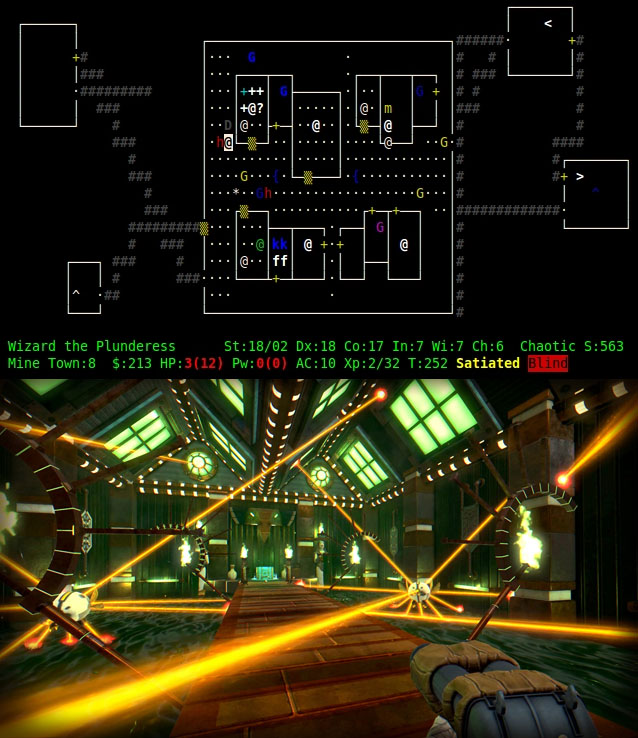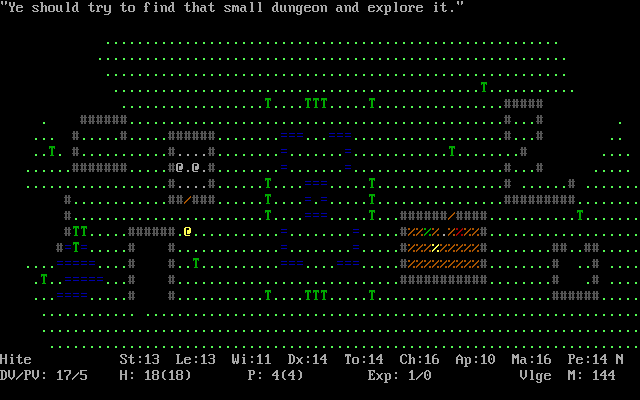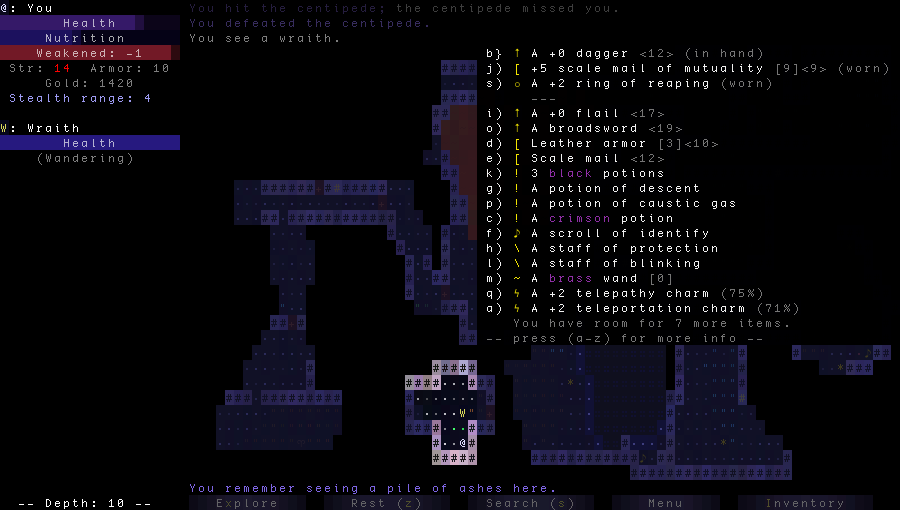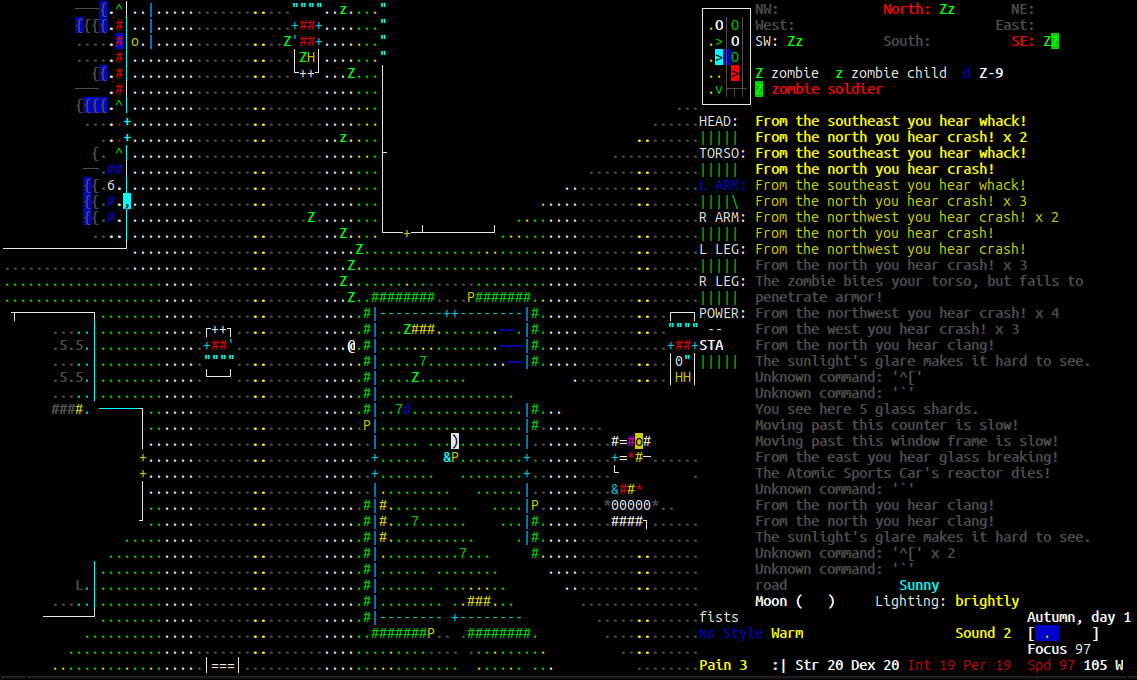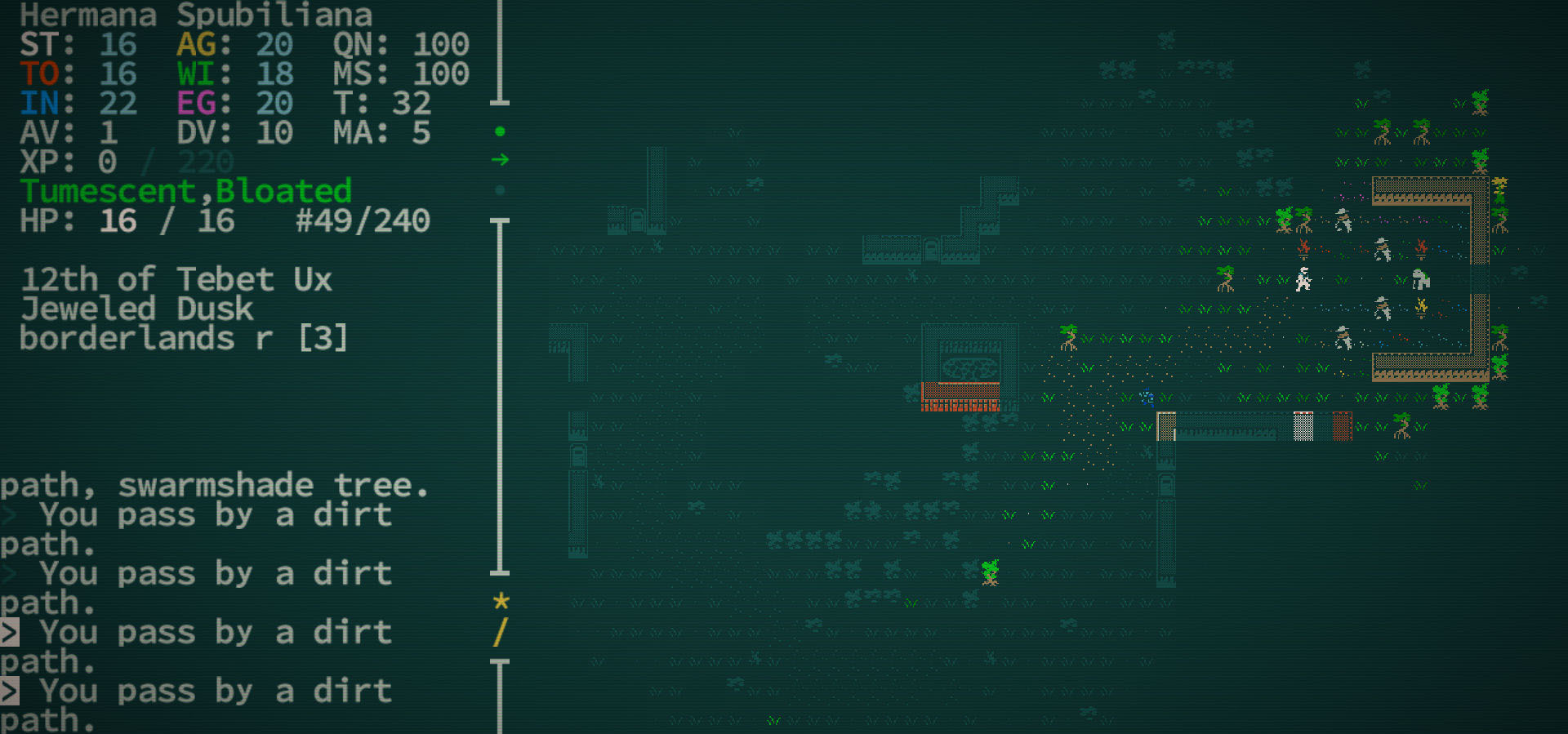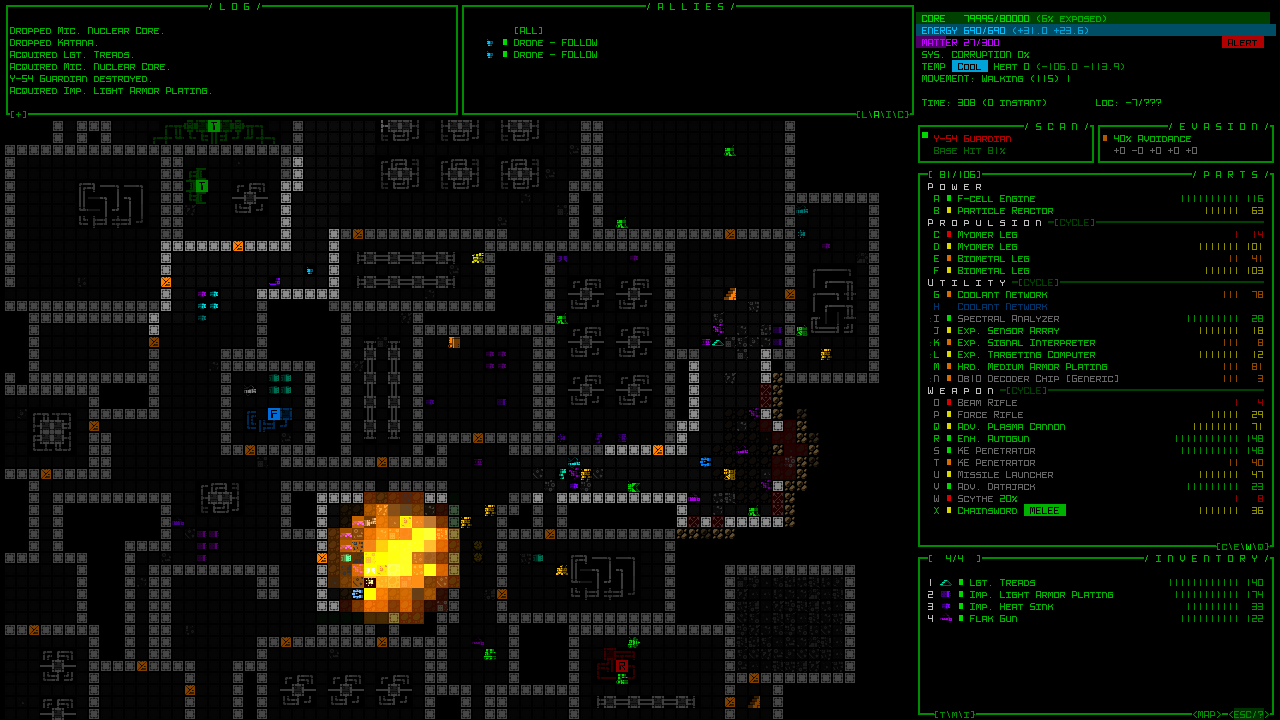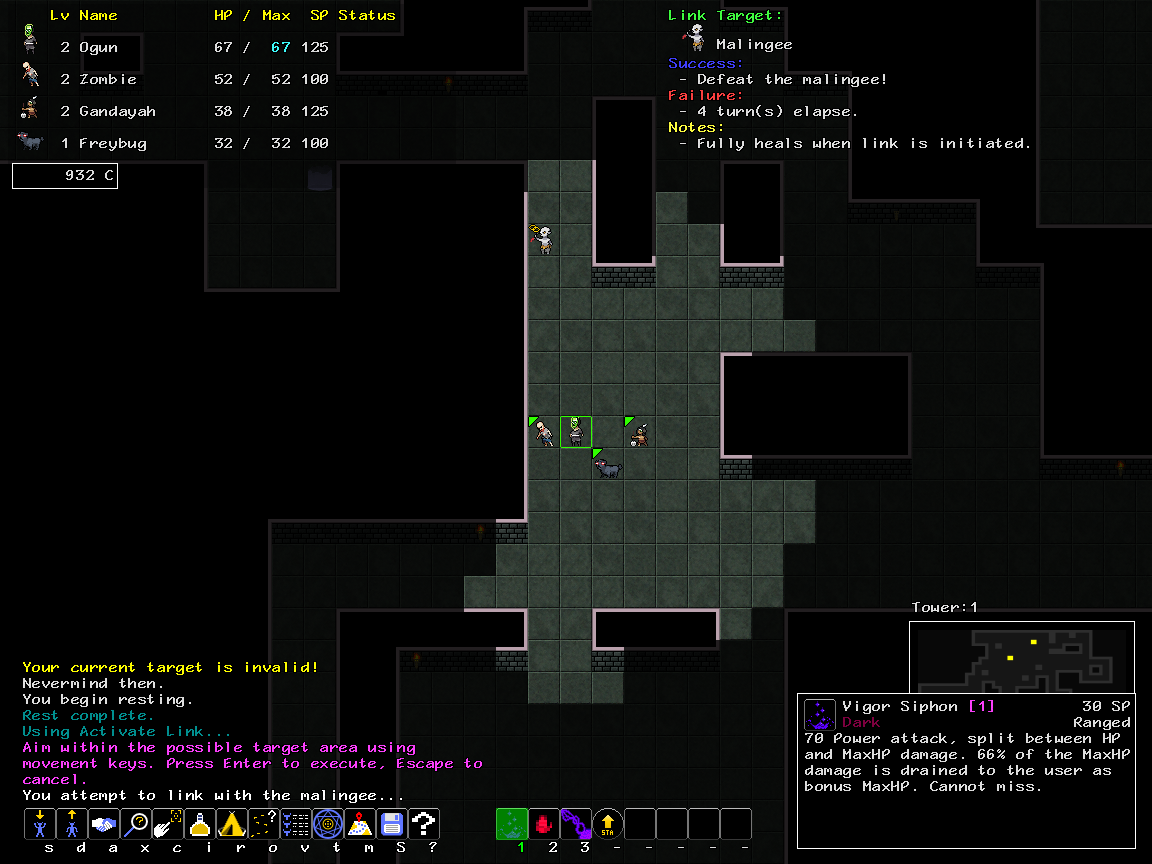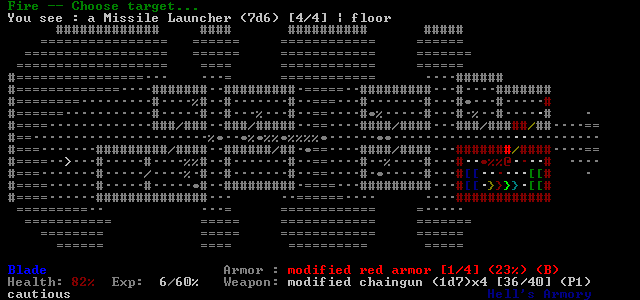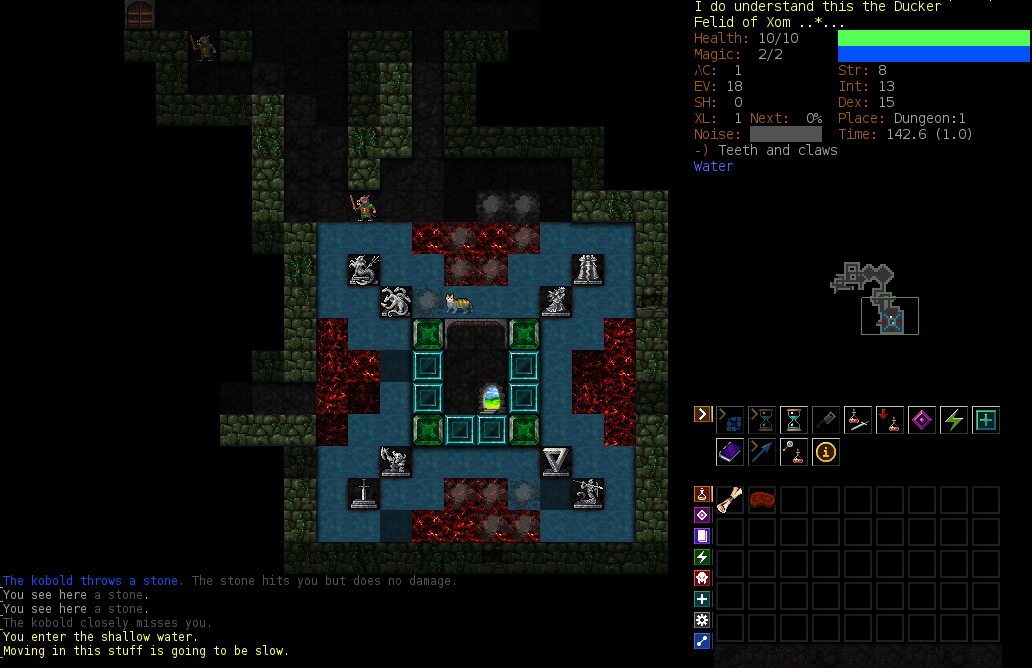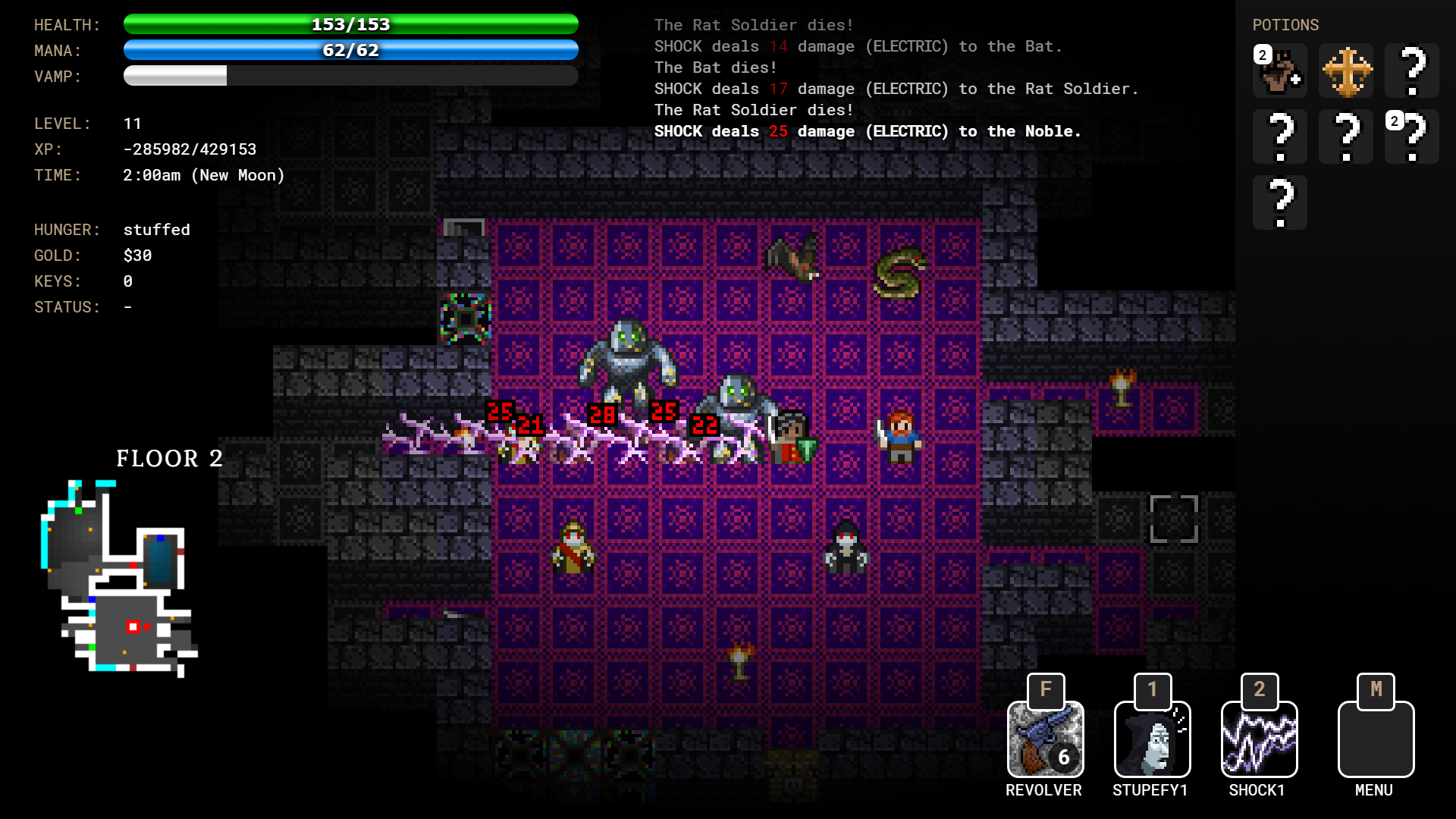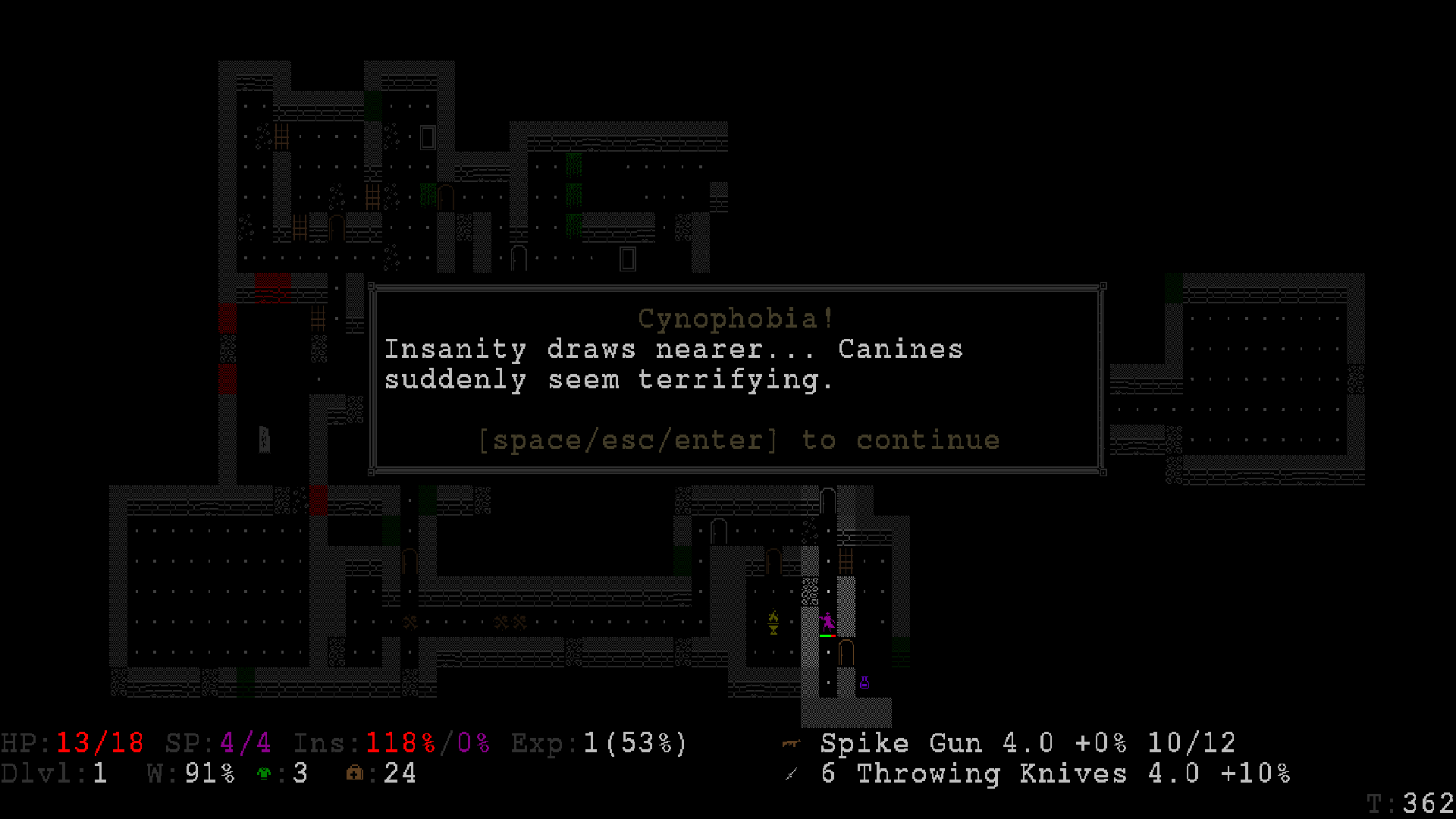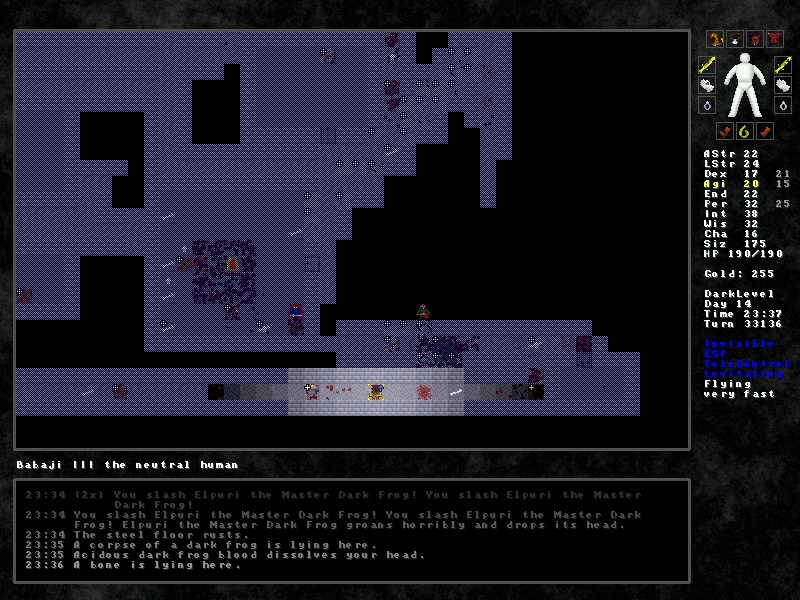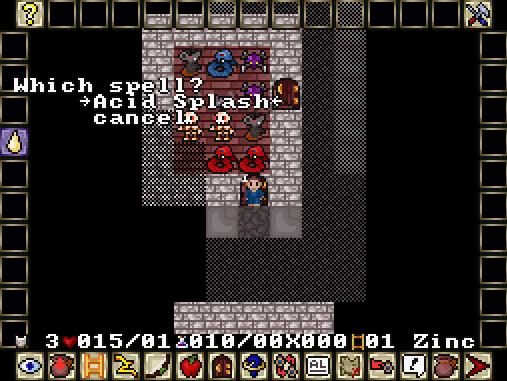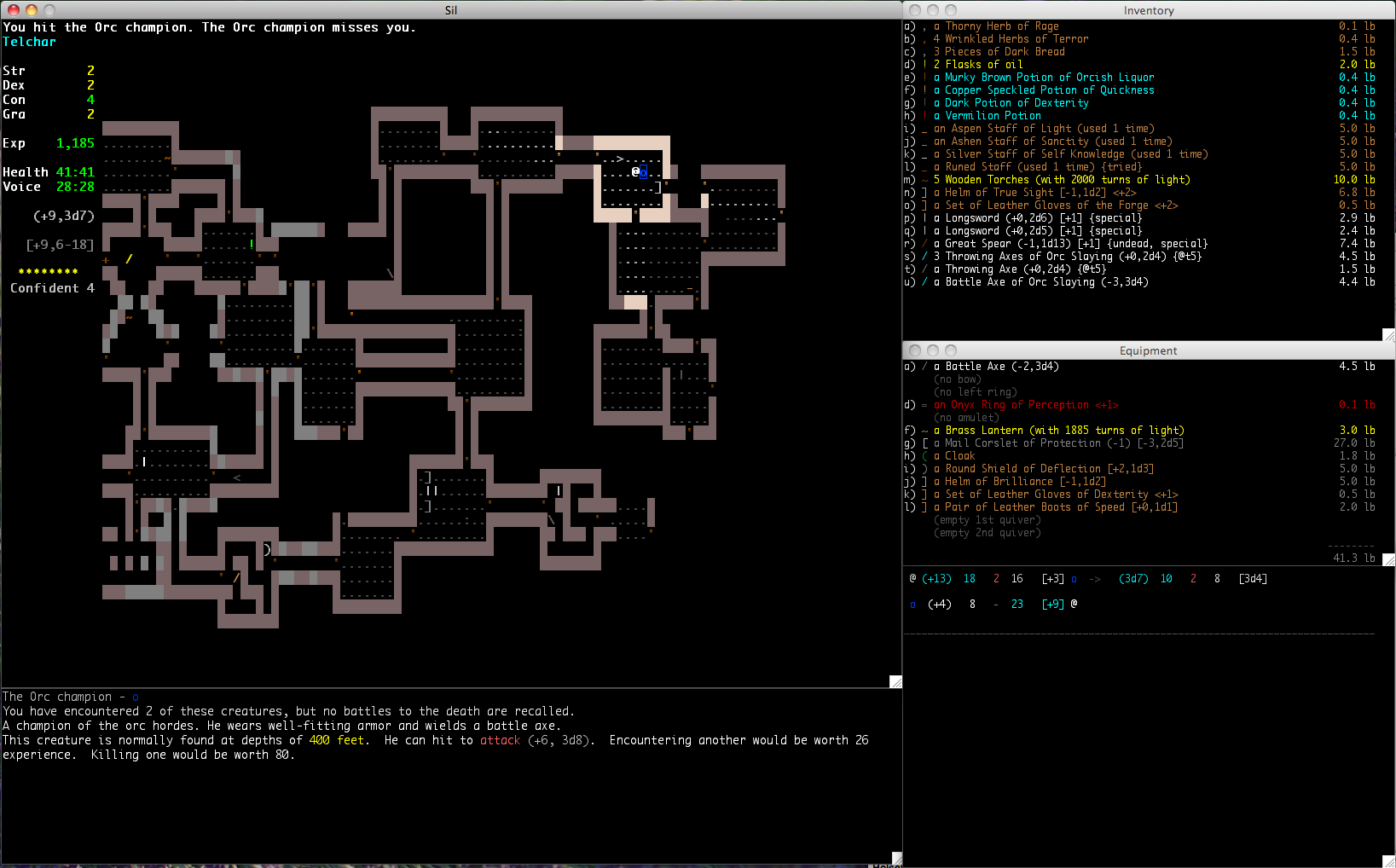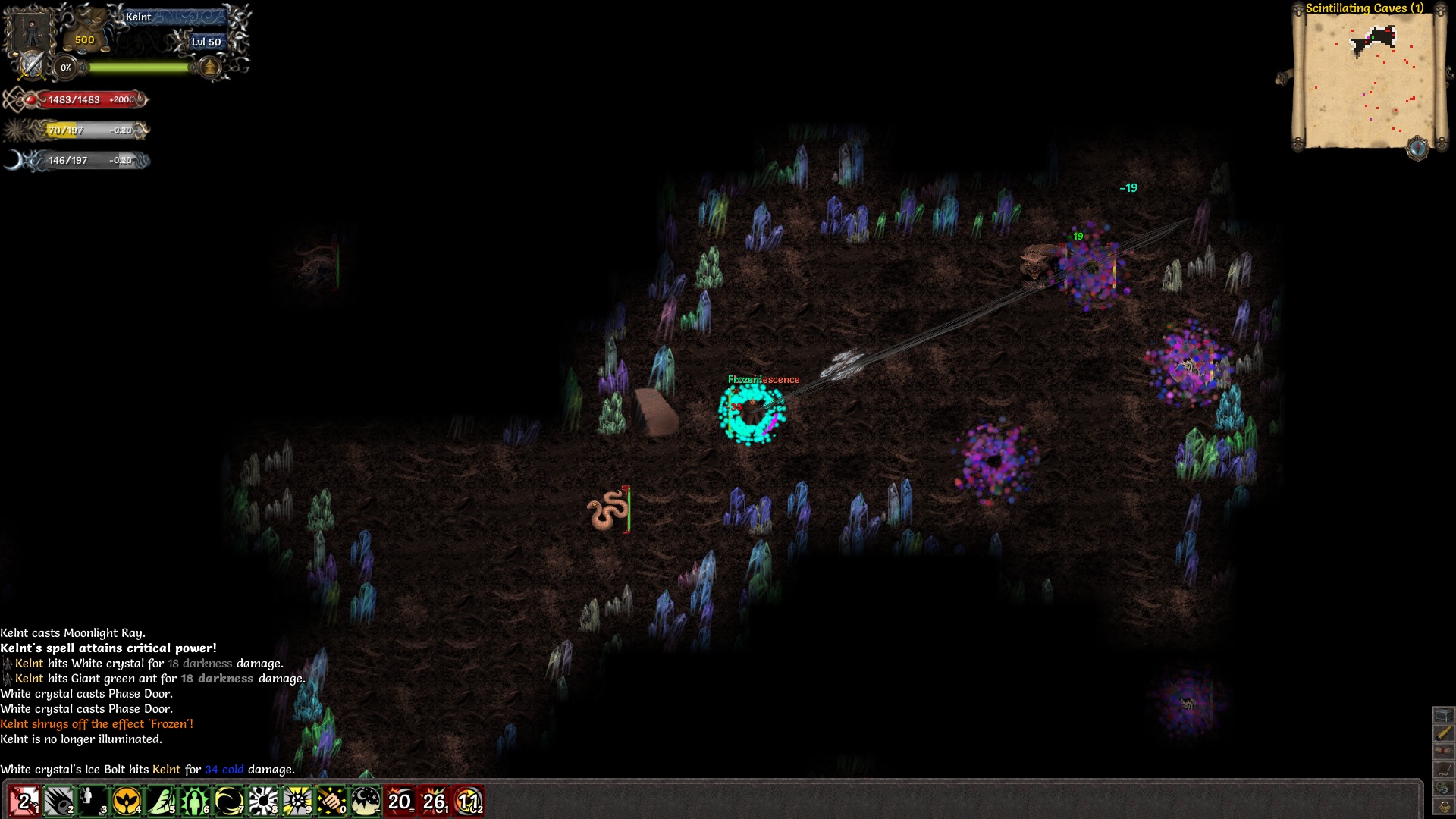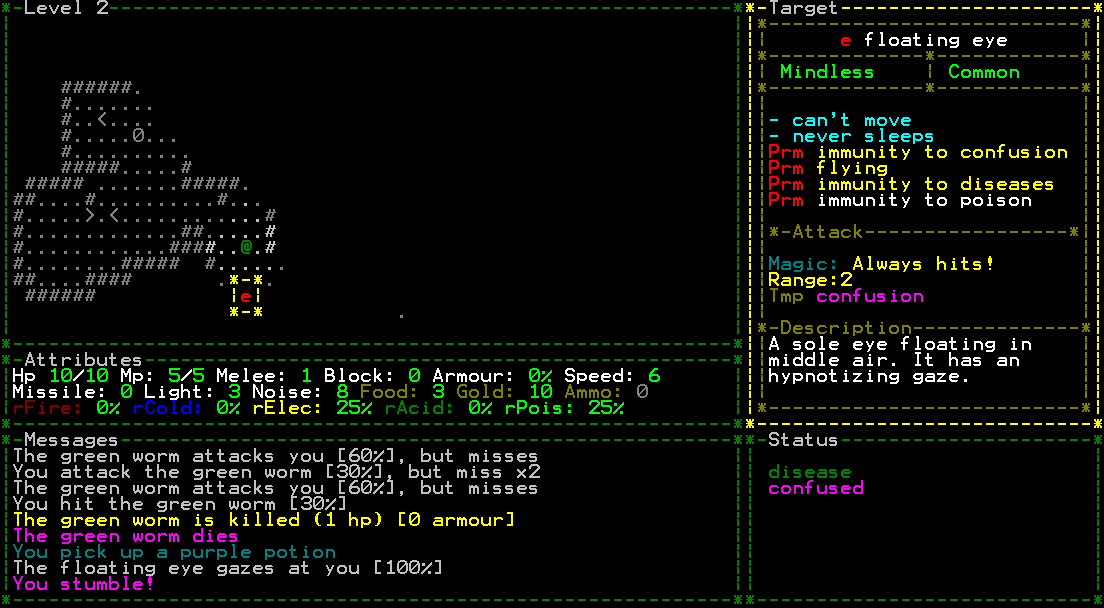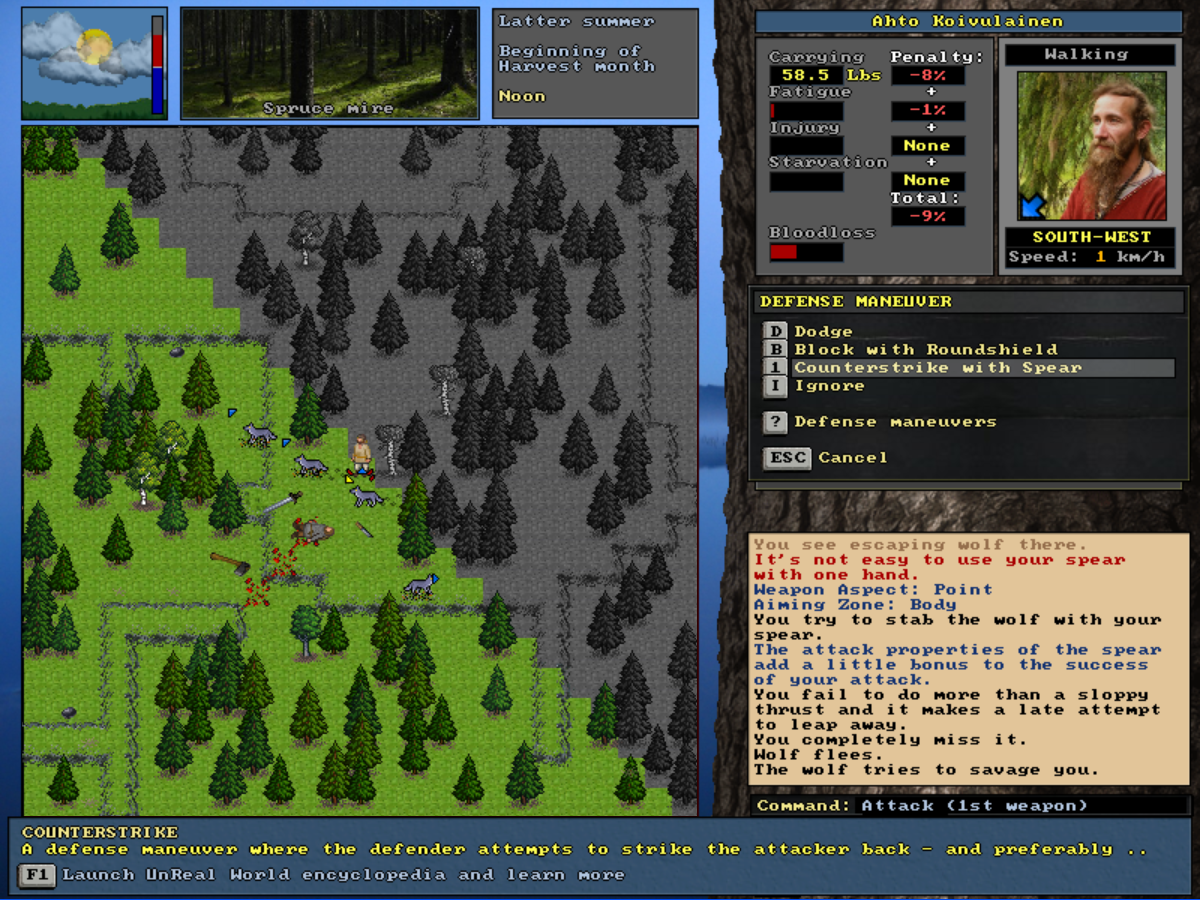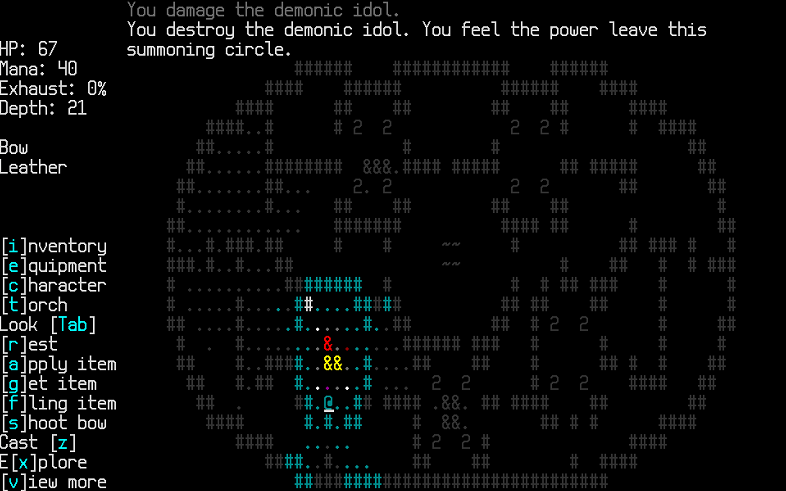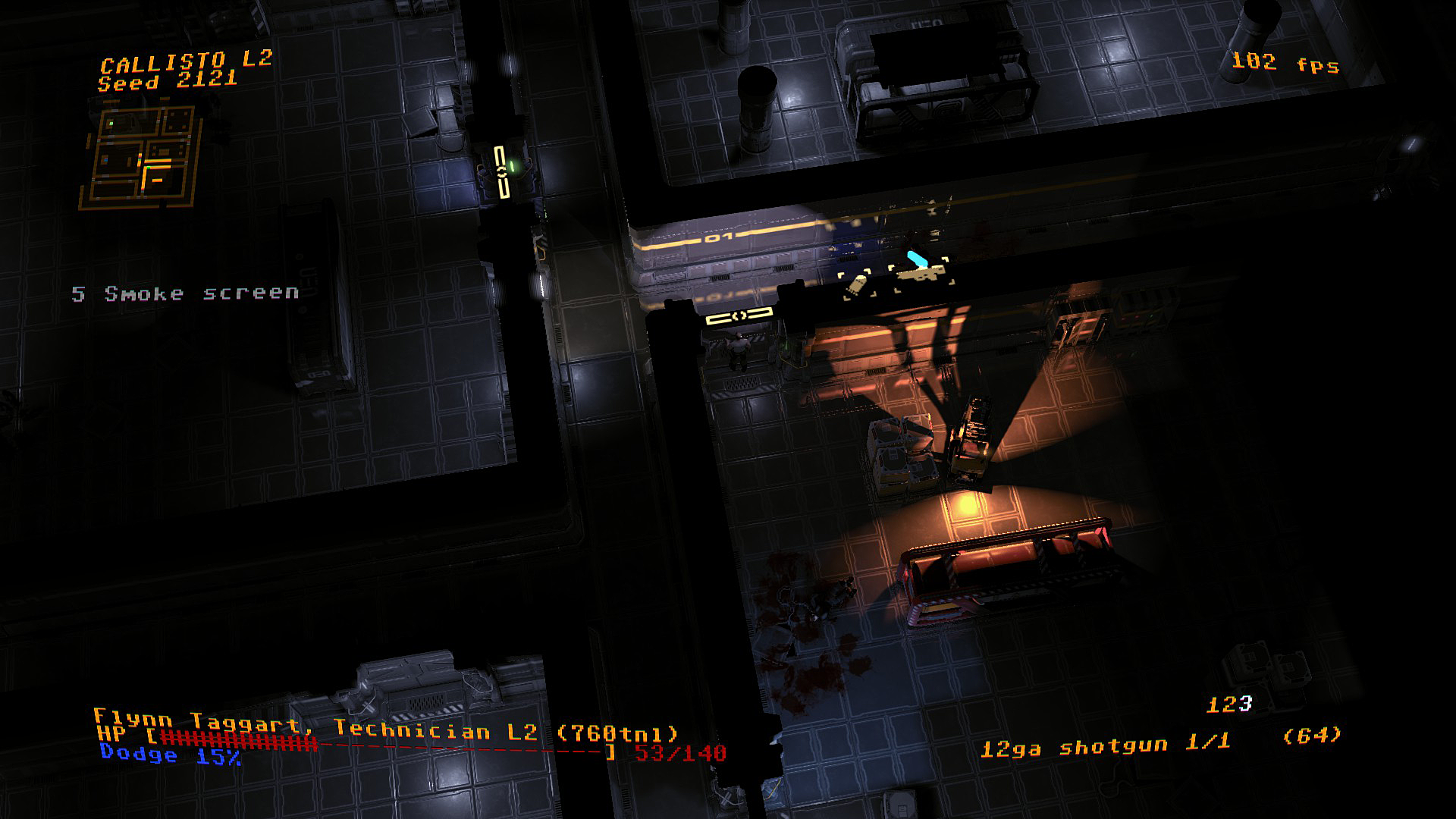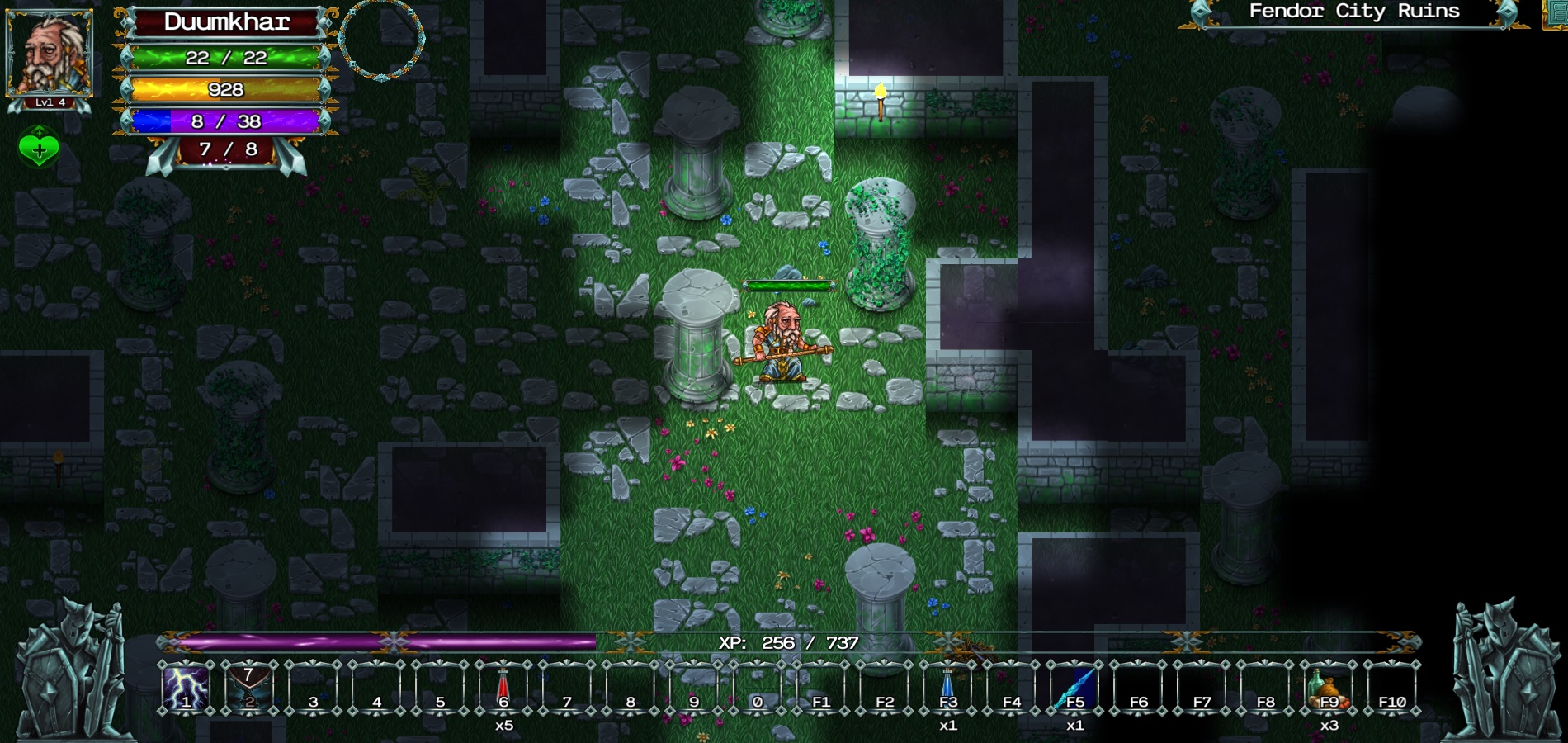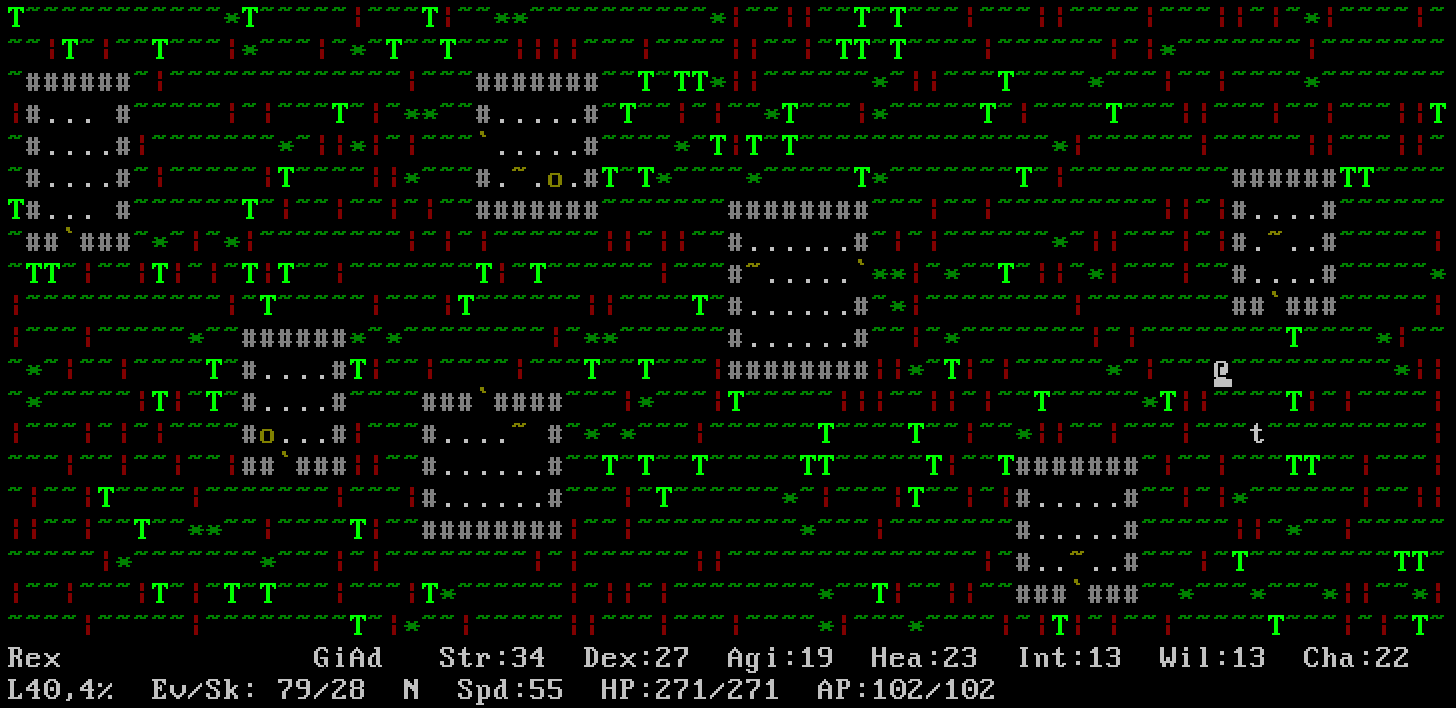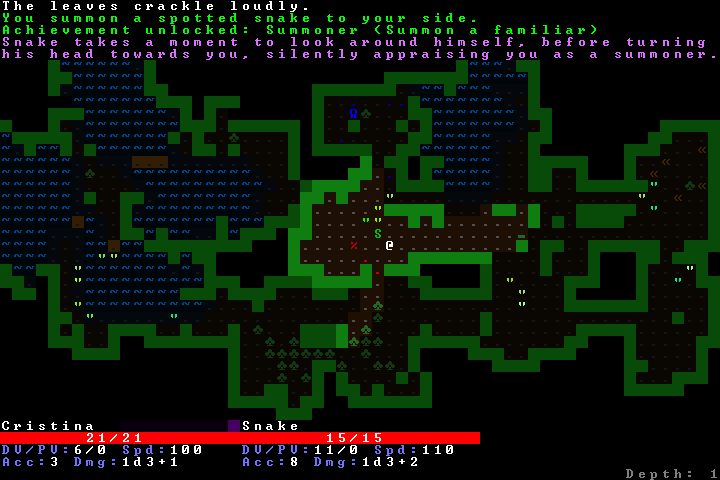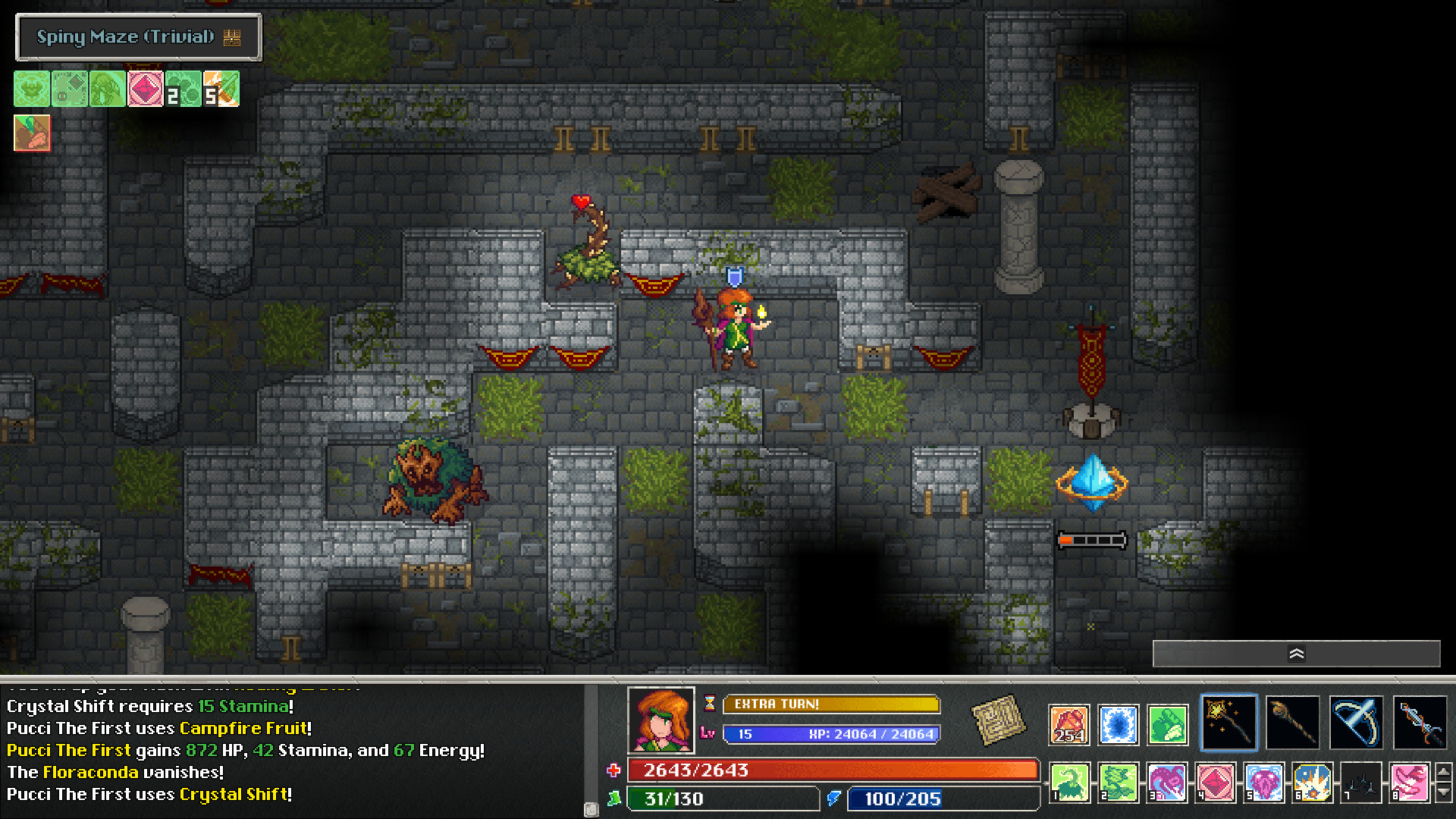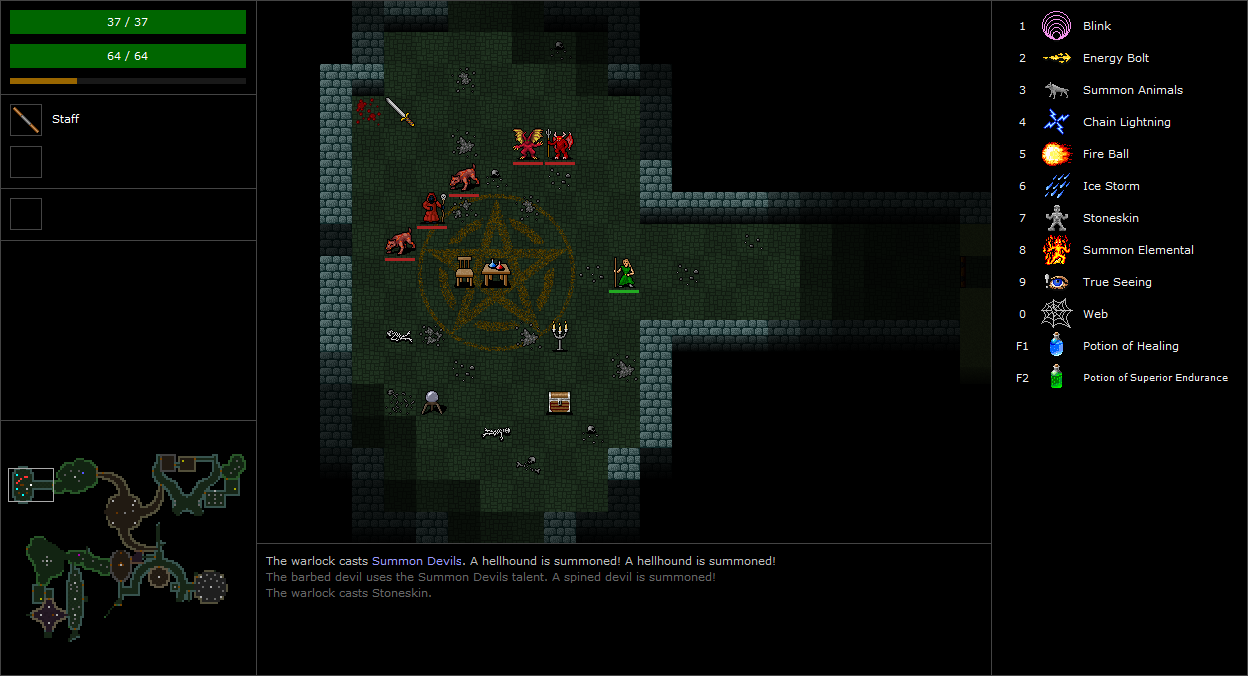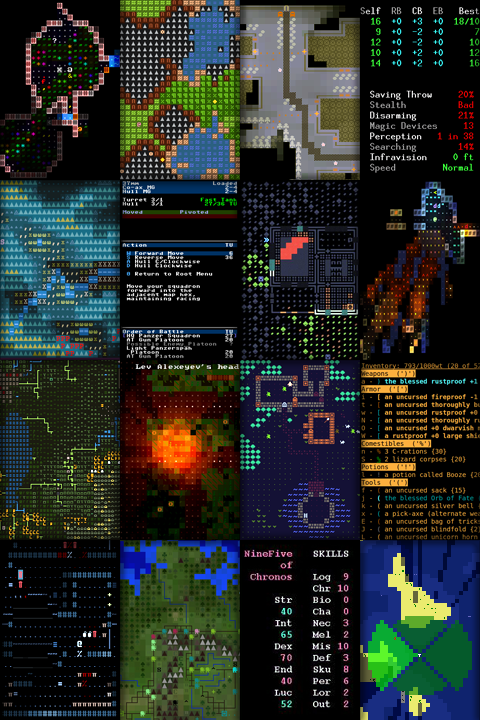In the beginning there was the Berlin Interpretation… Just kidding, believe it or not there were arguments about what constituted a roguelike long before 2008, but in the decade since then we’ve entered a new era in the wider roguelike genre in which that lone word itself has become increasingly diluted as mainstream games easily overtook the original more closely related set of games in popularity, allowing the common definition to shift and expand almost beyond recognition. Depending on who you ask now, “roguelike” can refer to games as disparate as these:
At the top we have NetHack, and on the bottom is Tower of Guns, where the latter and other equally distant examples (borrowing maybe one or two aspects of roguelikes) are generally referred to as “roguelites” by people familiar with the time before this newer expansion.
Personally, I am very much in support of the expansion of the genre in every direction, injecting roguelike values into other genres to create new types of enjoyable experiences. Although in some cases these games may veer pretty far from what some will accept as roguelikes, games that aren’t too far out on the fringes are also known to sometimes lead new players to discover “traditional roguelikes,” which is great!
Note: This article will sometimes simply use the word “roguelike” to mean roguelikes in the traditional sense unless otherwise stated.
One thing worth pointing out right away is that although I’m writing up a narrower take on roguelikes here and even recently started a community dedicated more explicitly to “traditional roguelikes,” I don’t recommend that developers try to adhere to a strict definition of what anyone thinks roguelikes are or should be. Too often in dev communities we hear from prospective developers worried that their game is “not roguelike enough.” Over on r/RoguelikeDev the definition is basically “whatever you think it is,” because interesting game development is often about testing and breaking rules and boundaries, after all. Trying to shoehorn a game for that perfect fit into a specific definition isn’t a really meaningful endeavor if it’s going to warp the game idea in a bad way or keep it from reaching its full potential. Develop the idea, not for a genre.
On that note, it’s also important to realize that “traditional” doesn’t mean that we’re necessarily talking about only old games here! (I would dub those older representatives “classic” roguelikes.) New traditional roguelikes are popping up every year, featuring plenty of innovation while remaining squarely within the traditional sphere.

For r/TraditionalRoguelikes I put together a banner of images from various roguelikes, a mix of old and new spanning decades (click and zoom for full-size).
Definition?
Giving “roguelike” a definition to satisfy everyone is an impossible task. Even within the core community of roguelike players well aware of Rogue, whether or not a game should be considered a roguelike is commonly attributed to each individual’s “feeling” and whether a given game adheres to the “spirit” of the genre as they understand it. Naturally these opinions are going to vary as much as these players’ respective experiences, even more so in a world surrounded by an increasing number of games each day. As I’ve seen over years of repeatedly watching relevant arguments play out online, many different perceptions of the roguelike spirit are clearly irreconcilable. The reason behind this was pretty eloquently summed up in this comment by silverlarch, reproduced here:
“Traditional roguelikes […] share specific qualities with Rogue, namely being grid/turn-based with procedural generation and permadeath. That’s not all Rogue is.
Let’s compare some games.
Rogue is a grid/turn-based dungeon crawler with full procedural generation and permadeath in a fantasy setting. It’s about descending through a multilevel dungeon to find the Amulet of Yendor and return it to the surface. It has no RPG mechanics: the only stats are health and strength. Your character is defined by the equipment you find along the way, and health increases with experience gained from killing monsters. You have to deal with identifying potions, scrolls, and items that may be beneficial or harmful. The dungeon is filled with monsters, traps, and secret rooms.
Tales of Maj’Eyal is a grid/turn-based dungeon-crawling RPG with permadeath and some procedural generation in a high fantasy setting. It has character classes and talents, experience-based leveling, meta progression in terms of unlocking new classes, an overworld map, quests, a skillbar, non-dungeon areas like towns, interactive friendly NPCs, and extensive shops. ToME is a traditional roguelike, but not a whole lot like Rogue.
Cataclysm: Dark Days Ahead is a grid/turn-based open world survival game with full procedural generation and permadeath in an apocalyptic zombie sci-fi setting. It has no end goal, RPG mechanics and a wide array of skills for character progression, base-building, vehicles, potentially friendly NPCs, quests, special abilities via mutated or bionic character upgrades, weather and time of day, injury and morale systems, and extensive crafting. C:DDA is a traditional roguelike, but really nothing like Rogue.
Brogue is a grid/turn-based dungeon crawler with full procedural generation and permadeath in a fantasy setting. It’s about descending through a multilevel dungeon to find the Amulet of Yendor and return it to the surface. It has no RPG mechanics: the only stats are health and strength. Your character is defined by the equipment you find along the way, and health and strength are increased by potions. You have to deal with identifying potions, scrolls, and items that may be beneficial or harmful. The dungeon is filled with monsters, traps, secret rooms, and minor puzzles. It has recruitable NPC monster allies, minor stealth mechanics, and environmental interaction in the form of gas, liquid, and fire mechanics. Brogue is a traditional roguelike, and about as close to Rogue as modern roguelikes get.
Unexplored is a realtime/pausable non-grid-based dungeon crawler with full procedural generation and permadeath in a fantasy setting. It’s about descending through a multilevel, branching dungeon to find the Amulet of Yendor and return it to the surface. It has no RPG mechanics: the only stats are health and strength. Your character is defined by the equipment you find along the way, and health and strength are increased by potions. You have to deal with identifying potions, scrolls, and items that may be beneficial or harmful. The dungeon is filled with monsters, traps, complex puzzles, and occasional secret rooms. It has minor stealth mechanics, occasional small shops, minor crafting, minor meta progression in the form of unlocking new basic starting equipment, and environmental interaction in the form of gas, liquid, and fire mechanics. It’s basically a realtime Brogue clone with a better proc gen engine and a few added mechanics. It is not a traditional roguelike, but very much like Rogue.”
Bullet points can’t accurately capture the breadth of the genre, even in its traditional sense.
At the same time, as I thought about ways to describe the “feeling” that adequately captures the roguelike spirit, I realized that even such a description can’t be meaningful in a vacuum--a list of core features is still a necessary component.
Now I normally don’t bother wading into the endless arguments on this topic, but having created a new community more explicitly centered around them I essentially forced my own hand and needed to write something xD. The aim is to try to be inclusive of at least a decent percentage of “personal definitions” floating around the core roguelike community.
Here goes!
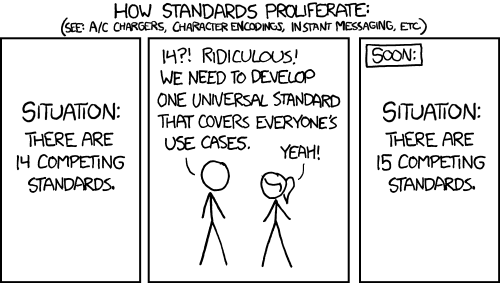
xkcd: Standards
What is a Traditional Roguelike?
First of all, hopefully you’ve actually read the above background info for all-important Context, and didn’t just skip down here :P
While “roguelike” is a somewhat more permissive term as used these days, traditional roguelikes have a stricter focus requiring all of the following elements:
- Procedural content: Some content, often the environment, is procedurally generated. This increases replayability by keeping the game interesting and surprising on repeated runs, while also making gameplay expertise more about mastery of tactical and strategic knowledge. Much of the play time in a roguelike is spent exploring, so procedural maps in particular are an effective tool for generating fresh experiences both on a local (different enemy compositions and room layouts for tactical analysis) and grander scale (different routes or orders to visit world locations?), especially where there are many types of environments and inhabitants to draw on. Maps can technically be procedural to different degrees, where one may have static vaults/prefabs integrated into larger generated maps in order to provide particular points of interest or even areas outwardly recognizable for their gameplay meaning. Note that even in identifying procedural content as a vital element in traditional roguelikes, consistency is still important in order to allow for learning and eventual mastery of the relevant systems.
- Permadeath: Death is permanent. To retain the element of surprise in a procedural world, consequences matter. Traditional roguelikes are “run-based” games in which save/load features exist only to continue playing at another time, rather than to redo actions and therefore lighten their meaning. As run-based games there is also little to no metaprogression--you grow as a player through knowledge and skill, but these aren’t explicit benefits carried over from one run to the next. A small amount of metaprogression is not a problem where there is a hard cap which is quickly reached and serves some other purpose in the design without breaking the consistency of its replayability. Growing ever more powerful with each run is a very anti-roguelike metamechanic, whereas unlocking lateral game content is technically fine. Note that some traditional roguelikes allow players to optionally forgo save/load restrictions, either to avoid permadeath or even to redo actions; at that point they’re not being played as a TRL, although this option doesn’t negate the game’s status as a traditional roguelike altogether unless that is the default and expected method of play for which the game was designed.
- Grid-based: Traditional roguelikes play out on a discrete grid with cell-wise movement and actions, aiding in tactical calculation. Combat must be non-modal and take place on the same map grid where exploration occurs, but non-modality is not a requirement for interaction with shops, towns, or a world map.
- Turn-based: Actions are carried out in a turn-wise manner, with the player taking an action followed by all other entities acting in turn. Turn-based action gives players unlimited time to react to changing and unexpected circumstances and weigh the permanent consequences in formulating a response, testing analytical skills rather than physical reflexes and quick thinking.
- Single player-character: The player controls a single primary character represented on the map, and the death of that character is the end of the game. It’s okay to have AI-controlled allies, partial control over allies, or even switching player control to an alternate character by means of in-game abilities, but the normal state of the game should not be controlling multiple disposable “units.”
As you can see from the list above, “traditional roguelike” isn’t nearly as limiting a category as one might think. Even within these confines there is practically limitless space for innovation on mechanics and content and theme.
But again there is also a second component to fully describing a traditional roguelike, the feeling that’s hard to put into words but both born of and complementing the list of features above.
Darren Grey touches on some of this in his description here:
“…in my view it’s inherently replayable, capable of surprising the player on many playthroughs. It rewards cleverness and tactical thinking. It cannot simply be learnt by rote, but it can be mastered with experience. It emphasizes gameplay before aesthetics, concentrating on making that replayable experience fresh and engaging on each play. It’s unforgiving, but all the more rewarding when you perform it well, offering an honest sense of achievement and satisfaction. Much of this satisfaction comes from the internal knowledge of having done well at the game itself, rather than artificially constructed rewards.”
(This could still be said to describe games that aren’t roguelikes, but it at least further links many games that also share the list of roguelike characteristics.)
With regard to “gamefeel,” I find roguelikes are both challenging and addictive in a way similar to many multiplayer games in that you’re up against uncertain challenges that are operating within parameters established by the game world, only this is the slow singleplayer version of that experience. Roguelikes rely on multiple or even numerous overlapping systems to create a complex web of emergent possibilities, increasing both the number and variety of challenges as well as the number of tools available for problem solving in any given situation. As a result they’re highly replayable, and you’re frequently encountering new and changing conditions. It’s the player’s job to navigate those systems both as the in-game character and as the meta player. This is where the heavy decision-making focus comes in (lots of variables to consider!), and while roguelikes are often played quickly, you sometimes need extra time to figure out the best course of action (hence the focus on turn-based action on a discrete grid), since any negative consequences could either immediately cut the run short or potentially reverberate throughout the rest of the game, thus adding weight to each decision.
/u/aaron_ds also has a good overview covering the mix between feeling and feature with roguelikes rooted in “accurate threat assessment in tactical scenarios generated by systems.”
In the end all the elements of a roguelike detailed in the earlier list strongly complement each other to produce a satisfying “roguelike gestalt,” and removing or altering any of these is likely to destabilize that balance and fundamentally change the experience. The result might be like a roguelike, but is likely already more appropriately classified as something else at that point. For example basing the gameplay on multiple controllable characters is more of a tactics game (X-Com!) with a different style of pacing, removing permadeath pushes a game into more typical CRPG territory where consequences are not nearly as pronounced, and adding real-time elements requiring quick reflexes or at least limiting decision-making time belongs in the explosive “action roguelike” subgenre.
Examples of classic roguelikes (more here):
Many classic roguelikes have since gained one or more optional tilesets, although all began with ASCII as shown below.
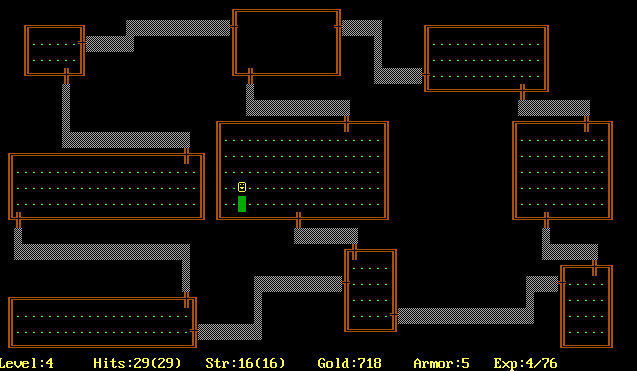
Rogue (1980)
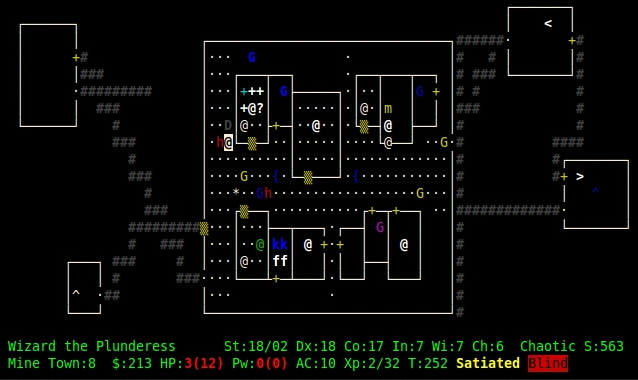
NetHack (1987)
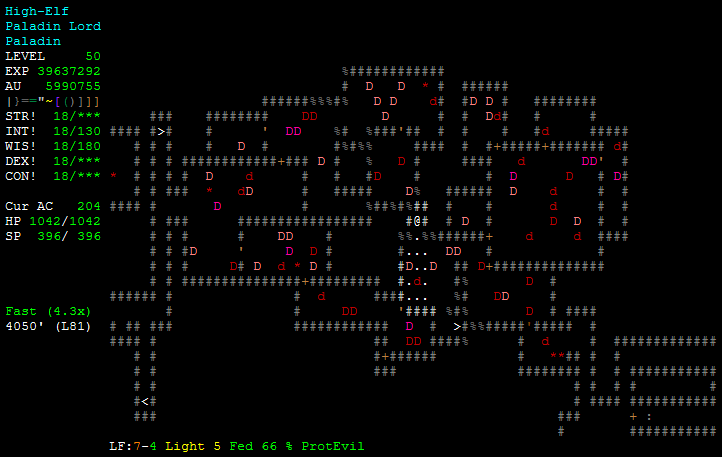
Angband (1990)
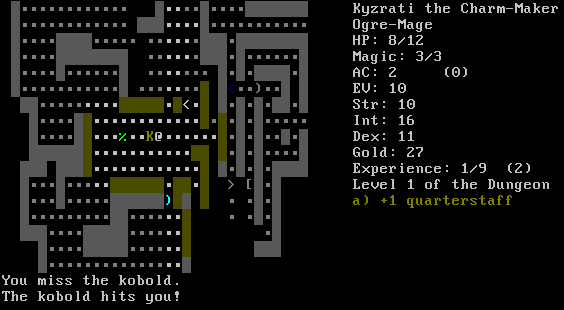
Crawl (1995)
Examples of modern roguelikes:
Among more modern roguelikes you can see a significantly wider visual variety, including a number that don’t even support ASCII, or are at least don’t use it by default.
In the r/TraditionalRoguelikes sidebar I’m also maintaining a list of of excellent newer/underplayed roguelikes people can explore. As of this writing the list includes:
Features that might suggest a roguelike, or be related to them, but aren’t absolutely necessary for most players:
- ASCII: Minimalist aesthetics with visuals boiled down to sometimes little more than the essential tactical factors are pretty common among traditional roguelikes, but not required since graphical fidelity is tangential to roguelikes being rooted in gameplay mechanics.
- Identification system: All the way back to Rogue, many roguelikes include a system of unknown items that may be identified by external methods, risking their use, or deduced through other means. This is one of many systems to interact with, and adds yet one more strategic aspect to exploring a procedural environment.
- Inventory management: Although very common in roguelikes since an inventory offers the player a familiar and intuitive way to collect and organize the various tools for tackling challenges, technically a roguelike could achieve that goal using other means such as abilities and other types of resources.
- RPG elements: Stats, character classes, and leveling--roguelikes tend to have some amount of these, if not many, to provide the player with pathways for progression and further increase options for replayability and hooks for interactive systems.
- Monster-player similarity: Mechanics governing players also apply to monsters, e.g. both can have inventories, equipment, use items, cast spells, etc. Although not a direct requirement, on the development side this approach does a good job of facilitating the wider range of clever interactions for which the genre is known, especially where other entities are using the same internal architecture as the player and therefore a greater number of features and interactions can easily be applied equally to both.
- Dungeon environment: In the early days a majority of roguelikes took place in fantasy-themed subterranean maps composed of rooms and corridors. Today fantasy roguelikes still outnumber other types, but even among traditional roguelikes the genre has since expanded into many different types of environments as well.
- Keyboard support: Ideally most or all actions are accessible without using the mouse, allowing players to quickly transition from one important decision to the next.
- Quick action resolution: Actions carried out by both the player and other actors are usually instantaneous and involve minimal or no animation (or at least easily skippable animations), giving the player full control over the pacing. By extension there’s also usually a message log recording details of events as they occur in case the player misses something or needs additional details.
Examples of features/game types that aren’t considered traditional roguelikes:
While many of these might fall under the wider roguelike umbrella, and people who enjoy traditional roguelikes will likely enjoy them, this doesn’t make them traditional roguelikes :P
- Real-time elements. Physical reaction times shouldn’t be an influential factor in roguelike play.
- Games with no local map at all (lots of card-based games do this).
- Puzzle-type roguelikes. These are often deterministic and play out on a small board without involving exploration, featuring lower levels of resource management (if any) and fewer abilities and problem-solving tools in general.
- Modal combat, for example JRPG-style encounters which occur in a space off the explored map.
History and References
Previous definitions:
- The original Berlin Interpretation on Rogue Basin
- “What is Traditional Roguelike?“, by Slash at Temple of the Roguelike
Other references:
- “Roguelike” on Wikipedia, a fairly good overview of its history
- Slash’s article on the origin of the word “roguelike” and its use in classification on Usenet
- Darren Grey’s article “Screw the Berlin Interpretation!“
- The original Roguelike Definitions discussion thread on r/TraditionalRoguelikes, which served as some of the source material for the creation of this article
